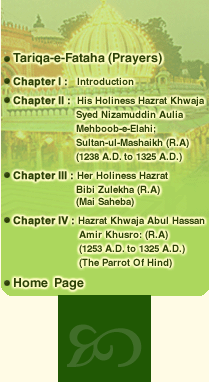(1) Life
History
After the death of his father, he came
to Delhi to his grand father’s (maternal) Imadul Mulk (Rawat
Arz) house. He grew under his grand father’s guardianship.
When Amir Khusro was twenty years, his grand father who
was 113 years old in 670-71 A.H when he left the world.
He was disturbed and was looking for an established career.
He joined as a soldier in the Army of Malik Chajju - a nephew
of Balban. But his poetry brought him in the Assembly of
the Royal Court where he was highly honoured. The devoted
mother brought him up and little is known about his modest
mother Hazrat BiBi Daulat Naz. He grew up as a soldier and
a poet.
When he was forty seven years old (698
A.H/1298 A.D.) his mother and brother died. He cried like
a child and said:
"A double radiance left my star this year
Gone are my brother and my mother,
My two full moons have set and ceased to Shine
In one short week through this ill-luck of mine."
Khusro’s homage to his mother on death was:
"Where ever the dust of your (mother)
feet is found it is like a relic of Paradise for me."
Once, Bughra Khan son of Balban was
invited to listen Amir Khusro. He was so enchanted that
he bestowed countless gold coins. The prize impaired the
relations with his master Chajju Khan. Khusro left him and
went to Bughra Khan, where he served for four years and
came to fame. In 677 A.H/1277 A.D. Bughra Khan marched towards
Bengal to crush the coup and Amir Khusro accompanied him.
Bughra Khan was then appointed ruler of Bengal but however
Amir Khusro came back to Delhi.
The eldest son Khan Mohd of Balban
(who was in Multan) came to Delhi. When he heard about Amir
Khusro he invited him to his court. Finally Amir Khusro
accompanied him to Multan in 679 A.H/1279 A.D. Multan at
that period was the gateway to Hind and a centre place of
knowledge and learning. The caravans of scholars, tradesmen
and emissaries transited from Baghdad, Arab, Iran to Delhi
via Multan. Amir Khusro says that:
"I tied the belt of service on my waist
and put on the cap of companionship for another five years.
I imparted lustre to the water of Multan from the ocean
of my wits and pleasantries."
Amir Khusro and Amir Hassan Sijzi were
happy under his patronage.
Amir Hasan Sijzi was younger to Amir
Khusro by two years. Both were in the company of the celebrated
historian Hazrat Moulana Ziauddin Barni the writer of "Tareekh-e-Ferozshahi"
who completed it after thirty one years of Amir Khusro’s
death. His Shrine lies south to Hazrat Amir Khusro’s (R.A)
Shrine.
In the year 683A.H./1283A.D Jinar Khan
a Mongol, invaded India. Khan Mohd along with many soldiers
were killed in a fierceful battles and Amir Khusro came
back to Delhi and describes as follows:
"In the furnace of torture, I too fell a
prey to the heathens; one of the tied me by a rope to the
saddle of his horse and made me run in front of his horse.
What a torture it was."
 —Hazrat Nizamuddin Aulia (R.A.).
—Hazrat Nizamuddin Aulia (R.A.).
|





